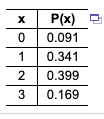A sociologist randomly selects single adults for different groups of three, and the random variable x is the number in the group who say that the most fun way to flirt is in person. Determine whether a probability distribution is given. If a probability distribution is given, find its mean and standard deviation. If a probability distribution is not given, identify the requirements that are not satisfied. 1. Does the table show a probability distribution? Select all that apply. A Yes, the table shows a probability distribution. This is the correct answer. B. No, the random variable x's number values are not associated with probabilities. C. No, the random variable x is categorical instead of numerical. D. No, the sum of all the probabilities is not equal to 1. E. No, not every probability is between 0 and 1 inclusive. 2. Find the mean of the random variable x, or does table does not show a probability distribution? 3. Find the standard deviation of the random variable x, or does table does not show a probability distribution?
Contingency Table
A contingency table can be defined as the visual representation of the relationship between two or more categorical variables that can be evaluated and registered. It is a categorical version of the scatterplot, which is used to investigate the linear relationship between two variables. A contingency table is indeed a type of frequency distribution table that displays two variables at the same time.
Binomial Distribution
Binomial is an algebraic expression of the sum or the difference of two terms. Before knowing about binomial distribution, we must know about the binomial theorem.
|
A sociologist randomly selects single adults for different groups of three, and the random variable x is the number in the group who say that the most fun way to flirt is in person. Determine whether a
|
1. Does the table show a probability distribution? Select all that apply.

Trending now
This is a popular solution!
Step by step
Solved in 3 steps with 3 images









